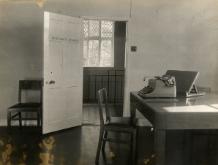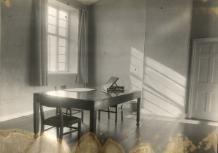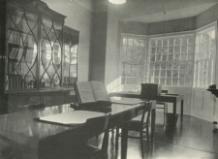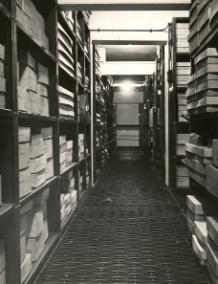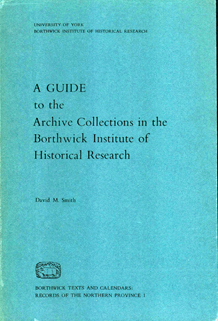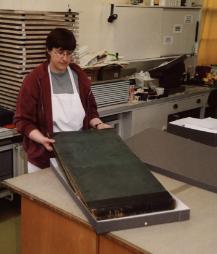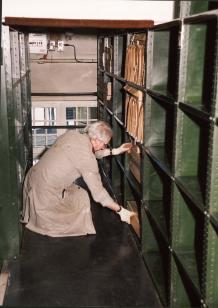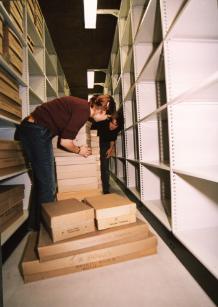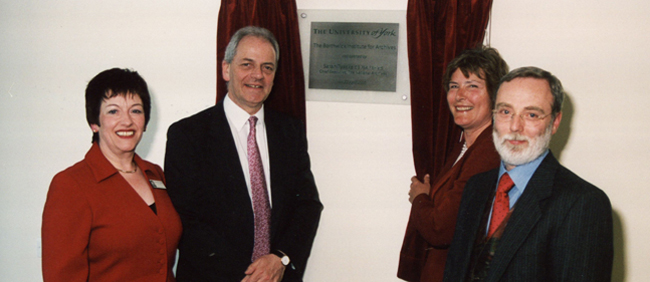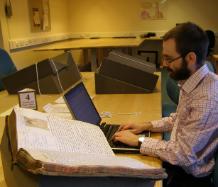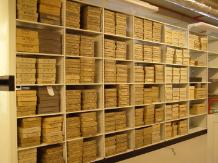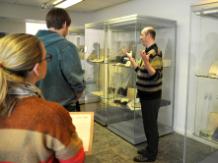Our story
Although times have changed, one can still see much continuity in the work of the Borthwick today and in our earliest days. Our distinctive character was set from the beginning.
1953 - 1973
The searchroom office, waiting
to open, 1953
The Borthwick Institute opened at St Anthony's Hall in 1953, under Rev. J.S. Purvis as Director. For the first ten years the Borthwick was run by the Academic Development Committee of York Civic Trust (to 1956) and then by the York Academic Trust (1956-1963). These were both independent bodies which had no national or local government support. The Borthwick's running costs were met mainly from its endowment, the Borthwick Trust. This allowed a modest establishment and resources, and larger scale projects had to be funded by special grants. The Borthwick became part of the new University in 1963 but continued to be run on very economic lines.
The Borthwick at first occupied only the medieval wing of the St Anthony's Hall complex, and was relatively small in size. Two strongrooms were created below the medieval hall. Upstairs there were a number of small rooms to one side of the hall forming interlinked searchrooms; on the other side of the hall was a teaching room. There were also staff offices – not only for the Borthwick staff but also for the Executive Secretary of the Academic Development Committee. The Hall itself was open to the public during the Institute’s opening hours, and was used for exhibitions
One of the searchrooms, 1953
Staffing initially consisted of a Director with an assistant archivist, joined, in the late 1950s, by a records clerk and a secretarial assistant. In 1961 a full time secretary was appointed, and in 1963 a part time typist. A junior archivist post was created in 1962, and a full time document repairer in 1964. A caretaker and three cleaners looked after the building.
The Borthwick immediately attracted both academic researchers and genealogists, and during the first 20 years searchroom users burgeoned, from 405 in 1956 to 1,276 in the academic year 1968/9 and 1,748 in the year 1970/1. Staffing was gradually increased: a strongroom assistant was appointed in 1967 and, in the same year, a part time (later full time) archivist’s post was created, based at the Borthwick but responsible for the York Minster Archives (the post lasted until 1981). In 1972 a further junior archivist and a full time document repair assistant were added.
The Director's office, 1953
However, as was common at this time in record offices, the Borthwick was top heavy with professionals. This enabled higher level archive activities to be initiated, which publicised and made the archives widely available, but it also meant that these activities could be curtailed by the daily routine demands of producing documents for visitors and answering routine enquiries or searching records on other people’s behalf.
Demands on the archivists' time became steadily more onerous, especially with the great increase in the popularity of genealogy in the 1960s and 1970s. The appointment of the strongroom assistant in 1967 was designed to relieve this pressure. In the meantime, those wanting searches done on their behalf began to be routinely directed to professional record agents, and stocktaking weeks were introduced in 1963 to give staff some uninterrupted time for sorting and working on the archives.
Special projects 1953 - 1963
In the early days of the Borthwick, just as now, larger tasks were undertaken through grants and special funding for special projects.
- The Borthwick had been set up in 1953 through the generosity of the Pilgrim Trust, and this body made further grants in 1958-9 for boxes and shelving in the wake of the arrival of the massive probate archive.
- In 1954 the Leverhulme Trust had awarded a research grant of £15,000 per annum for three years for a survey of the administration of ecclesiastical jurisdiction in York: three researchers were employed from1955 to 1962.
- Between 1957 and 1961 a grant of £1,600 from the Carnegie United Kingdom Trust enabled the Borthwick's archives to be more fully catalogued, and summary lists of the Borthwick holdings were circulated to 80 record offices and libraries.
In the early 1970s, in the wake of long term staff absences through illness, the Borthwick had temporarily to close on Fridays (a similar temporary arrangement had to be made again in 1981 because of staff shortages).
As numbers of users continued to grow, visitors were being turned away daily as the searchrooms filled up, so an appointments system was established (the appointments system remained in force until the Borthwick moved in 2004).
It was also apparent that heavily used series like the parish register transcripts were beginning to suffer from wear and tear, so from March 1972 all genealogists were charged for consulting them; the money thus raised was used for pressing, repairing, rearranging and making surrogate copies. Not until later was the problem of potential deterioration of genealogical sources through overuse solved by the microfilming of parish register transcripts (completed by 1980), parish registers (done in the 1980s) and the acquisition of microfilms of probate documents from the Public Record Office (during the 1980s).
Archives on the mezzanine level
of one of the strongrooms
The increase of staff and activities in this period meant that the Borthwick became very pressed for space. The other half of the St Anthony's Hall complex was occupied by York City's Day Continuation School, and not until 1968/9, when the school vacated, was the University able to lease the rest of the buildings.
As a result, in 1970 the Borthwick gained much needed extensions. The east wing was converted to a library (renamed the Gurney Library in 1974) and above it was created a new, large and better equipped conservation unit. A room in the north block provided for the first time a dedicated staff room.
However, resources allowed no further immediate physical expansion and the searchrooms remained small and cramped. The rest of the space at St Anthony’s Hall was leased by the University to the newly created York Archaeological Trust, and although it was anticipated that this lease would end within five to ten years, the Trust ceded occupation only gradually and not until 1995 did the Borthwick gain control and occupy the whole of the complex.
The Borthwick and the wider archive world
In the 1960s, under Norah Gurney as Director, the reputation of the Borthwick within in the wider professional archive world was much extended, at a time when the network of record offices through Yorkshire and the UK was steadily growing.
Borthwick staff took a full part in professional activities through the Society of Archivists and other local and specialist history organisations.
In 1968 the Borthwick hosted the Society of Archivists’ annual conference and later, in 1976, the Society of Archivists’ annual meeting of conservators.
1974 - 2004
Under David Smith, who succeeded Norah Gurney in 1974, the Borthwick Institute’s profile as a specialist ecclesiastical archive and research base was reinforced. A year after his arrival, in 1970, the Borthwick became the Centre for Episcopal Acta, housing a central index and co-ordinating resource centre for research on episcopal acta (the charters and other official documents issued by medieval English bishops). When the British Academy began the editing and publication of its series of episcopal acta in 1973, Dr Smith was appointed the general editor.
The first Borthwick Guide, 1973
David Smith also undertook in the early 1970s a complete re-classification of the York Diocesan Archive, moving from the system devised by Canon Purvis to a functional arrangement based on the system devised by the historian and archivist Dorothy M. Owen.
His work resulted in the publication of A Guide to the Archive Collections in the Borthwick Institute of Historical Research (University of York, 1973).
During the 1980s, the Borthwick suffered cuts in staff as a result of financial stringencies. The number of archivists fell in 1980 from four to three and then, in 1988 from three to two and the number of conservators fell in 1989 from two to one. But the part time assistant secretary was made full time, funded through a new Borthwick searching service.
Despite cuts, the Borthwick remained a lively and busy place. In 1983 an annual Borthwick Visiting Fellowship in History was instituted jointly by the Borthwick and the History Department, whereby scholars on sabbatical leave were able to use the Borthwick as a research base in York. In 1985 an archive traineeship and a certificate in local history were significant new initiatives. And as a result of a bequest by the sister of Canon Purvis, an occasional series of Purvis Seminars on ecclesiastical history and sources was begun in 1988, with a first seminar on medieval parish clergy.
In 1985 the Borthwick had an Open Day which proved so successful that it was repeated, on a grander scale, to celebrate the 40th anniversary in 1993, when 500 members of the public came through the doors to see the building and learn more about the Borthwick’s work.
The Borthwick local history course
In 1985 the Borthwick began running a two year part time Certificate in Local History course, with between 12 and 20 students in each intake and the Borthwick archivists undertaking the bulk of the teaching. Tuition was given on historical sources, historiography, palaeography, and optional historical topics, with a dissertation in the final year. The course was popular and successful and ran in this format until 1990, but it placed intensive extra demands on Borthwick staff, so it was later organised under the auspices of the University’s Centre for Continuing Education. In 1987 a local history room was created at the Borthwick in 1987as a resource base for research on Yorkshire history and in 1988 a Borthwick Local History Forum was set up so that former students of the local history course and other local historians could meet and share their research and ideas.
Borthwick Archive Trainees
In 1985 an annual Archive Trainee’s post was established: this provided extra cover for the Borthwick at a time when the number of archivists was falling but also provided a great range of suitable experience for graduates contemplating an archive career. The post ran from 1985 to 2009 with trainees doing much more than simply manning the searchrooms: each trainee undertook a substantial task, such as producing an archive catalogue or a guide or organising a major exhibition. Many former Borthwick archive trainees can today be found in senior roles at other record offices.
During the 1990s and 2000s there were significant additions to the Borthwick's holdings.
In 1996 the library which had belonged to the late historian Professor Sir Geoffrey Elton was accepted, and was housed in a room specially converted to be 'The Elton Library'. For the first time, major archives began to arrive with specially negotiated funding.
In 1993 Nestle UK transferred the archive of Rowntree and Co, and funded the conversion of a strongroom, archive shelving, and a two year project archivist to produce a catalogue and guide.
In 1995 the large archive of York Health Services NHS Trust plus its part time archivist was transferred to the Borthwick, and the NHS funded the conversion of a room to a dedicated strongroom.
In 2001 an appeal to raise money for the purchase of the archive of the garden designer Jim Russell resulted in the funding of a one year post to catalogue the archive.
Major funded projects 1995-2004
Preservation packaging the NHS
archive, in a project funded by
the Wellcome Trust, 2001-2From the 1990s onwards, opportunities through funding bodies for archive projects became more common and numerous.
- In 1995 the Borthwick was awarded a £57,000 Follett grant for conservation work, under which two conservators and a trainee conservator were recruited to form a (temporary) regional centre for Higher Education conservation.
- In 2001-2 and 2002-4 the Borthwick had two grants from the Wellcome Trust Research Resources in Medical History Scheme (a further grant was to come in 2007-9). These provided for staff and resources to preservation package the NHS archive and to catalogue the Retreat archive.
- In 1995 the Borthwick gained a temporary research assistant funded by the Historical Manuscripts Commission for a year to survey and list Yorkshire Manorial Records: this is now an online resource.
- In 1995 the British Academy funded a temporary research assistant to assist in the Episcopal Acta project and in 2001 a British Academy Post-Doctoral Fellow joined the Borthwick for three years.
During this period, procedures for accessing and protecting information became more prominent and important, with the coming into force of the Data Protection Act (1998) and the Freedom of Information Act (2005). The University Registrar set up a working party on university records in 1998, and a records management strategy was drawn up by Chris Webb, Acting Director of the Borthwick, and approved in 2002. In 2003-4 Chris Webb also drew up the first Freedom of Information Publication Scheme for the University, and a University Records Manager was appointed in 2004, to be based at the Borthwick.
From 2000 initiatives began in electronic cataloguing. In 2001 the Borthwick was one of several Yorkshire record offices to collaborate in the regional 'Yorkshire Signpost' project to put electronic collection level descriptions of Yorkshire archives onto the new Access to Archives database, hosted by The National Archives.
Moving on, 2004-5
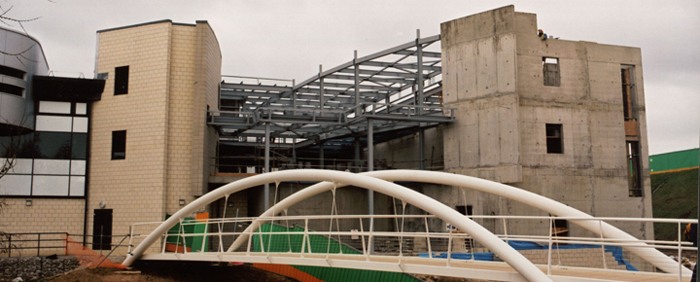
Construction of the new Borthwick building
By the mid-1990s, the Borthwick had finally come to occupy the whole of the St Anthony’s Hall buildings but it was even more pressed for space. The Borthwick had either to expand and build on site, or move.
Moving archives off the old
shelves at St Anthony's Hall, 2004
The lease of St Anthony's Hall by the City Council to the University expired in 1994. At that time the possibility was explored of the Borthwick merging with York City Archives at St Anthony's Hall but in view of the low loading capacity of the Hall itself, there was limited potential for utilising existing buildings; it was decided to put merger talks on hold since any merger would involve a new building on the site. Lease negotiations dragged on, inconclusively, over the next five years.
Moving archives onto the shelves
at the new Borthwick, 2004
In 1999, the Borthwick Institute took the initiative to suggest that the University should apply to the Heritage Lottery Fund (HLF) for funding to build a new Borthwick Institute at a central campus location: this would be on a site immediately behind the newly built Raymond Burton Library.
The first stage application bid to the HLF was submitted in 2000. In 2002 the university was awarded £4.4 million pounds for the new Borthwick.
In summer 2004 the old Borthwick closed and, over the following six months, a very carefully managed move was made to the new state of the art premises. The new Borthwick opened to the public in January 2005.
2005 to the present
The opening of the new Borthwick in 2005
Left to right: Elizabeth Heaps, University Librarian; Professor Brian Cantor, Vice-Chancellor; Sarah Tyacke, Chief Executive of The National Archives, who opened the Borthwick; and Chris Webb, Keeper of Archives
After the move, the Borthwick ceased to be a small independent department and became part of the University Library and Archives. Today the Borthwick is part of the Information Directorate, which recognises the role of archives and records management within the University's information strategy.
Using archives in the new
Borthwick searchroom
Between 2005 and 2012, in-person researcher numbers were 23% higher than in the decade before the move. Family history enquiries have become more complex and wide ranging, becoming increasingly about ‘history’ rather than merely ancestor counting. There has been a revival of interest in the use of probate material by local groups. Meanwhile, outreach via family history fairs, special archive events and through social media and a Borthwick blog has steadily increased interest. The Borthwick continues to benefit from volunteer work by York Family History Society and the University of the Third Age, and by students wanting experience of working with archives and – a new venture – by volunteers helping with conservation work.
Borthwick staff continue to provide teaching and assistance with University classes at graduate and undergraduate level, but in recent years the scope of collaboration has extended, so that staff now work with the Centre for Medieval Studies, the Centre for Renaissance and Early Modern Studies, and the Departments of Archaeology, Economics, Sociology, History, Health Sciences, English, History of Art, and the School for Business and Society. The Borthwick was involved in, and hosted the launch of, the University’s 50th Anniversary Oral History Project, in 2013.
This recent period has been characterised by a great inpouring of new archives of all types and an increasing number of project partnerships, both within and outside the University.
The Ayckbourn Archive
A notable addition to the Borthwick holdings came with the purchase by the University in 2012 of the archive of Sir Alan Ayckbourn, with the support of the Heritage Lottery Fund, the V&A Purchase Grants Fund, the Samuel Storey Charitable Trust and the Friends of the National Libraries.
This involved a close partnership with the School of Arts and Creative Technologies and the University’s Widening Participation initiative through which, during 2012-2013, performance events and an online resource were developed and a Comedy Outreach Officer was appointed, who worked with over 500 young people aged 14-18 (including 12% from ethnic minority backgrounds) from more than 25 different educational institutions, on comedy workshops and in seeing and using the archive.
Archives in one of the new
strongrooms
A partnership with Harewood House Trust resulted in a Heritage Lottery Funded project in 2007, employing a conservation assistant to conserve and make available online a cache of fragile papers relating to the slavery and plantation interests of the Lascelles family of Harewood.
A further partnership, begun in 2011, with the University of Dublin and the Departments of Bioarchaeology and Chemistry at the University of York involves investigation of the feasibility of extracting reliable DNA information from historic parchment, which offers exciting research potential.
There have been a number of digitisation projects. The Andrew W. Mellon Foundation funded, during 2007-2010, a joint project with the Borthwick and the History Department to provide an on-line database of the cause papers in the diocesan courts of the Archbishop of York, 1300-1858. These are the most extensive records of their type in the UK, and of immense research value (they were originally listed by Rev J.S. Purvis while fire-watching during the Second World War). The database was launched in 2010. A further JISC funded project in 2011 digitised these cause papers so that images were attached to the database.
In 2010, the University of York funded a digitisation pilot project involving the Tuke family archive, investigating problems and solutions in the creation of digital catalogues and images through the University's Digital Library.
Other digitisation projects are currently underway or being planned.
Supporting Archive Conservation
In 2007 - 2009 the Wellcome Trust funded a third Research Resources in Medical History project at the Borthwick, to conserve the patient records of the Retreat. The project employed a conservator and conservation assistant. The project conservator, originally trained at the Borthwick, later became the Borthwick’s senior Conservator.
In 2010, the annual archive trainee post was discontinued, and converted to a post of conservation trainee. This was designed to address current problems in the recruitment and training of archive conservators. Archive conservation training was built into the terms of the Lascelles slavery conservation project so that the project assistant could begin her conservation training at the same time, becoming the Borthwick's first conservation trainee. She was later successful in winning a Queen Elizabeth scholarship and an award from the York Consortium for Conservation and Craftsmanship to further fund her training and she gained her Certificate of Archive Conservation, with a distinction, in 2011. She was then promoted to the post of archive conservator, raising the conservation staff back to its old level of two.
In 2011 the Andrew Fleming Conservation Fund provided funding for a suction table and training for the senior Conservator as an instructor in parchment conservation, a significant step towards the Borthwick being recognised as a national centre for parchment instruction.
In 2011 another conservation project funded by the Patricia and Donald Shepherd Charitable Trust appointed a conservation technician for three years to work with volunteers and to relieve the Borthwick conservators of day to day tasks, freeing them to conserve the most fragile of the plans and drawings in the Atkinson Brierley archive.
Funding from two legacies for local history purposes provided the resources to place most of the Borthwick's probate indices online through the British Origins website. The Borthwick was also a prime mover in the formation of a Yorkshire consortium of archive repositories to make all Yorkshire parish registers (excluding the West Riding) available through the Find My Past website.
Special projects have involved various project staff at different times, but permanent staffing has also increased. In 2005, under the terms of the HLF grant for the new Borthwick, the Borthwick gained one extra archivist and 1.5 extra archive assistants. In 2010, a joint post of University Special Collections and York Minster Librarian was appointed to join the Borthwick staff. In June 2012 the Borthwick appointed a Digital Archivist, and staffing now also includes reprographics and digital assistants.
Although the annual archive traineeship ended in 2010, the Borthwick became, in 2011, one of the partners of The National Archives in their 'Skills for the future' project, intended to increase the diversity of people working in archives. Two trainees annually were taken during 2011-2014, all receiving training and delivering a tangible project during their year.
A tour for a visiting group
The Borthwick has changed immeasurably since its opening in 1953 – today there is a larger staff, housed in 21st century premises, dealing with new and challenging demands and more numerous and varied activities. But our ambition to provide a high standard of expertise and scholarship has not changed since 1953. The Borthwick was opened to make York a 'world centre of history' and our ethos in the 21st century retains all that was best from the ambitions of our founders in 1953, translated into a modern context.
Our Mission Statement describes how we continue what we have always tried to do since our founding in 1953.
Our Mission Statement
We support and expand the University of York's cultural endeavour and contribute to human understanding through collecting archives, preserving them and making them widely available for research to all people, now and in the future.

